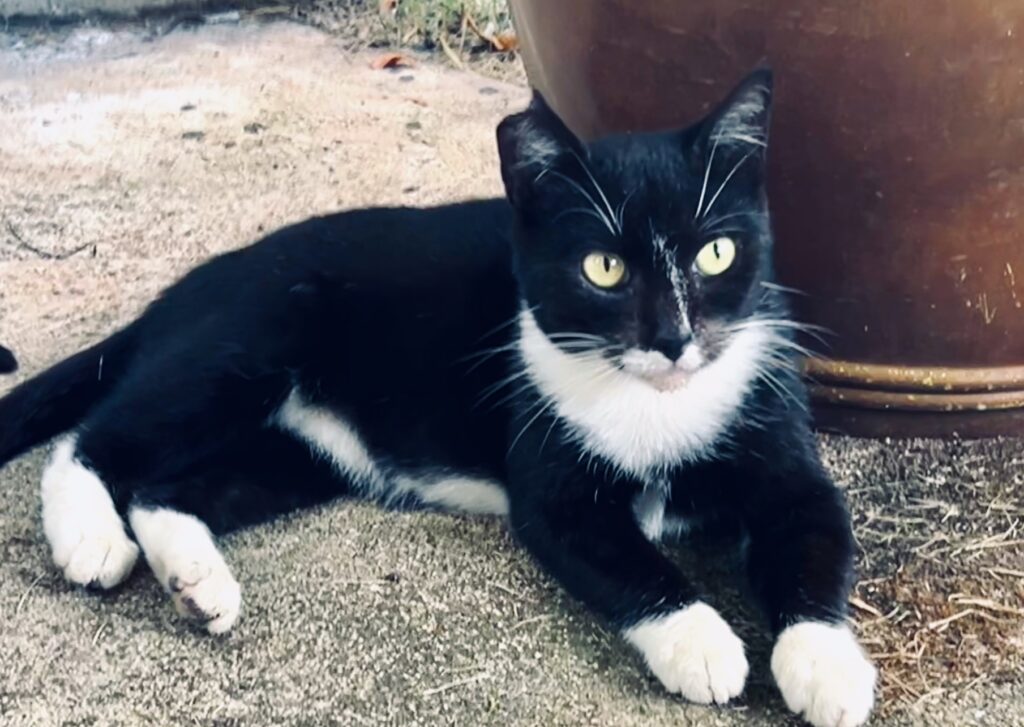Mewla here.
A new cat started hanging around in our neighborhood this month. The cute tuxedo was afraid of people and spent most of her time under parked cars.
A feral cat, also referred to as a “community cat,” is a homeless cat who was not handled as a youngster and has not been socialized to live in a home with humans. As a result, most are wary of people and typically prefer to live on their own in the outdoors.[1]
Roving red-headed reporter Ginger Grrrl had been keeping an eagle eye on the new feral cat. She didn’t want the tuxedo to become a pregnant teenager, like Ginger had been before we adopted her.

A female cat can become pregnant as early as four months of age. If not neutered, one cat can have hundreds of kittens in her lifetime. Because of cat overpopulation, nearly one million cats are euthanized (put to sleep) every year in the USA.[2]
Trap-neuter-return (TNR) programs are a humane alternative to killing animals. TNR involves trapping the cats, sterilizing them (spaying for females or neutering for males), and giving them vaccinations. The cats are also ear-tipped to identify those who have been spayed or neutered. The cats are then returned to their community, often where a caretaker ensures they are fed and healthy. TNR is the best way to humanely address cat overpopulation while allowing the cats to live out their lives.[1]
If you discover a feral cat living in your neighborhood, there are excellent websites and podcasts that provide detailed guidance.[3,4,5] But as an overview, you can follow the steps we took below to help a feral cat.
Step 1. Confirm That the Cat is a Feral
In our case, the tuxedo was afraid of people, and our neighbors confirmed that she was a feral. She also did not have her ear clipped, suggesting she hadn’t been sterilized.
Step 2. Begin to Feed the Cat Regularly
The tuxedo did not come near our home but seemed to feel safe under cars and on the street. We began by feeding her near the curb where we’d see her.
Step 3. Shape the Cat’s Habits With Food
Shaping is a way to modify how an animal behaves by rewarding small changes (in our case, we rewarded with cat food). After feeding the tuxedo near her favorite hangout (under cars) for a few days, we left food on the sidewalk, closer to our home. The day after, we presented her food several feet nearer. After she ate in that location, we fed her right next to our house. The tuxedo began showing up on our lawn and waiting for her dinner before we put the food out. She had been shaped!

Step 4. Borrow a Trap and Reserve an Appointment.
We contacted our friend Josie, a trapping and fostering advocate extra-ordinaire from the Hawaiian Humane Society (HHS). Josie borrowed a TNR trap on our behalf from HHS’s TNR program. Because traps are expensive, shelters usually ask for a deposit.
The Humane Society had many cats on its TNR waiting list, so we had to wait for an opening for the tuxedo to be seen by a Vet. The delay gave us several days to get the tuxedo used to eating food inside the trap.
Will a Cat Hold a Grudge if you TNR?
Step 5. Prepare the Cage and Trap the Cat
I asked Neighborhood Cats Director Susan Richmond how to make the trap more comfortable for a cat. She suggested that we add a mat or cardboard to the floor. Also, since it tends to rain every night in our windward Hawai’i town, Susan suggested that we tape a plastic cover on the top of the cage to keep the food and flooring dry.
After feeding the feral inside the trap for several days, the date of our appointment arrived. We set the trap, added some yummy food, and waited. Luckily, within the hour the tuxedo was trapped! At the Humane Society, the tuxedo was examined for illness, spayed, and given vaccinations. We were happy to learn that she was healthy.
Many animal welfare groups offer discounted spay/neuter surgeries for feral cats. To find a low-cost spay/neuter location near you, contact your local animal humane society or search Alley Cat Rescue’s directory here.

Step 6. Return the Cat to Her Community
The next step (after the anesthesia wears off overnight) is to allow the cat to return to her outdoor home. Continue to give her food and water at about the same time everyday. If, possible, provide a shelter to protect the feral from cold, rain, and/or extreme heat.
When we released the tuxedo cat, we thought she might run away and never come back. But that night, at dinner time, she showed up in our yard. She decided that we’d have the pleasure of feeding her regularly.
Once we were adopted, we figured it was a good time to name her. We chose the name “Chi,” which means “energy” in Japanese. Similarly, in Chinese, Chi is the vital life force energy that flows through us and through everything. Also, Chi is the name of a famous cartoon cat (see shows-featuring-cats).
If we knew someone who had room for another cat, we could have tried to socialize Chi to live indoors. However, the shelters and our friends’ homes were too full to take on another cat. Luckily, Chi seems to truly be more comfortable in the outdoors.
Still, we wanted Chi to be safe from cars, predators, and bad weather, so we shaped her to enter our fenced-in garden area. After luring her in with a trail of kitty treats, we now only feed her in the garden. We also made a little house for her with a soft bed, and she likes it! Today, Chi sleeps safely in her kitty house every night and spends much of her day relaxing in our garden.
Feral Kitten Fact
According to Alley Cat Rescue [2], 80% of kittens in humane shelters are found outdoors, born from unsterilized, free-roaming cats. Not sterilizing feral cats is the primary reason why about 875 healthy, adoptable cats are euthanized EVERY DAY in the US alone.[2] Let’s work together to change this sad fact.
To Recap…
If not sterilized, one female cat can have hundreds of kittens in her lifetime. Because of cat overpopulation, nearly one million cats are euthanized every year in the USA alone.[2] TNR is the best way to humanely address cat overpopulation while allowing the cats to live out their lives.[1] Every animal deserves to have a life free of suffering and abuse.
We were glad that we had the means to care for a cat in our neighborhood. We can all educate others about this humane way to prevent unnecessary kitten killing. Thank you for doing your part to support our furry feral friends.
Please share a comment below.
REFERENCES & RESOURCES
- What is TNR? Downloaded 24aug2024 from https://www.neighborhoodcats.org/how-to-tnr/getting-started/what-is-tnr
- The Feral Fix. Downloaded 25aug2024 from https://www.saveacat.org/the-feral-fix.html
- Neighborhood Cats website. https://www.neighborhoodcats.org/
- Community Cats website. https://www.communitycatspodcast.com
- Alley Cat Rescue website. Alley Cat Rescue’s Guide to Managing Community Cats.





It’s so wonderful that you did so much to help Chi! Thank you!
I agree that TNR is the best solution. People are quick to complain about feral cats, but they need to do something to help them rather than just complain.